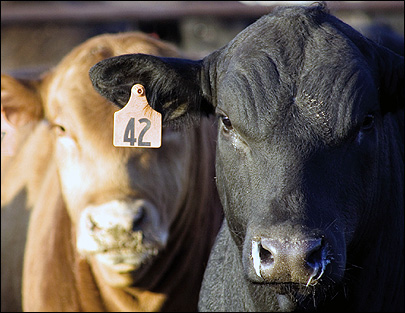Radio frequency identification technology is a valuable tool for tracking livestock, but the button-size RFID tags stapled into animals’ ears can fall off, and glass-encased RFID tags injected into skin can migrate deeper into the body and become unreadable. Somark Innovations, a St. Louis biotech startup, thinks it has a better solution: a permanent ink tattoo that relies on radio frequency waves to read and render unique identification numbers.
The chipless and antenna-less asset identification and tracking system uses biocompatible, translucent ink that can be tattooed onto livestock, pets, laboratory animals and even food, such as meat or fruit. The tattoo is applied using a micro-needle, which is actually a geometric array of many tiny needles, and each tattoo is made up of a unique pattern.

“The tattoo is applied at the same layer of skin as you’d do if you went to get a tattoo that says ‘I Love Mom,'” says Ramos Mays, who developed the technology and cofounded the company with Mark Pydynowski.
Somark is developing a proprietary RF reader that operates at a very high frequency to scan the tattoo. (The company says it cannot divulge more details because it is awaiting patent approvals.) The reader, which can discern numerous tattoos simultaneously from several feet away, translates the pattern into a unique ID number that can be associated in a database with a specific animal or asset.
Mays says his identification and tracking system should be less expensive than tagging livestock, though the company hasn’t set a price yet. “Anytime you start making a chip with circuits, the device complexity goes up, and that is directly proportional to cost,” he says. “But if you think about our raw materials, it’s ink, and ink is inexpensive. We have a tremendous cost advantage.”
Mays, who grew up on a farm in southwest Missouri, says the RFID tattoo will also solve some of the problems currently associated with RFID tags used to track livestock. There can be thousands of cattle on a single farm, and each cow has to move through RFID-enabled gates to ensure accurate reads of the tags. “The RFID tags don’t operate well enough to work at the speed of commerce,” says Mays. “If you miss one, you have to stop a 600- or 800-pound cow and turn it around.”
Once an animal is tattooed, the ID is permanent. Somark has performed toxicology tests on the tattoos and says the ink is chemically inert. Pydynowski says the tattoo is harmless, whether it’s inked onto skin or ingested. Mays, who has run his finger through the ink and ingested it, says, “It’s fine. I’m fine.”
Somark received some initial seed money and is now in the middle of a Series A equity financing round. Pydynowski says there has been a lot of interest in licensing the technology, and the company hopes to begin pilots in the near future.

